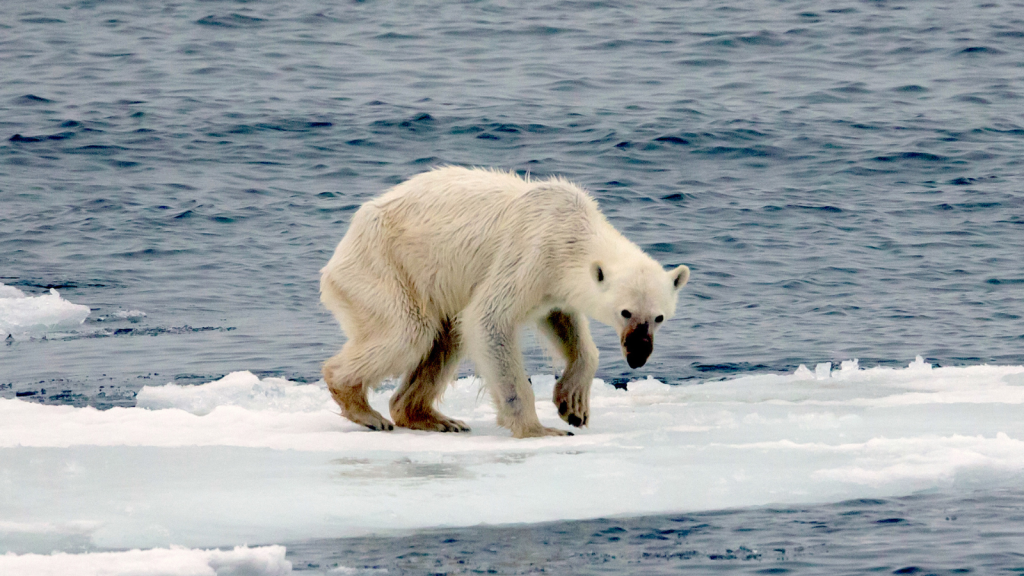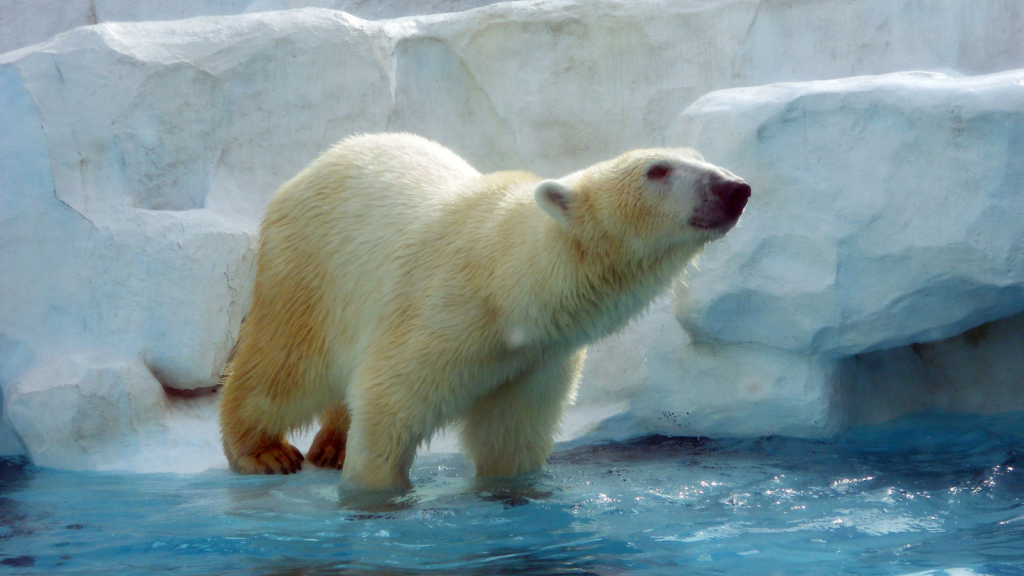Polar bears are magnificent creatures that have captured our imagination for centuries. These Arctic giants are perfectly adapted to life in one of the harshest environments on Earth. While we often see images of polar bears on ice floes or swimming in icy waters, there’s much more to these remarkable animals than meets the eye. From their incredible sense of smell to their unique hibernation habits, polar bears are utterly fascinating.
When I was a kid, Norwich Castle had a natural history section in their museum, and they had this polar bear. This poor, bedraggled, moth-eaten bear was stuffed and stood on its back legs in a parody of ferocious, fearsome life, even though the bullet hole was still visible in his once-mighty head. This profoundly sad sight has stayed with me all these years, and is one of the reasons I’m so incredibly passionate about conservation.
1. Their Skin Is Actually Black

Despite their white appearance, polar bears have black skin underneath their fur. This dark skin helps them absorb and retain heat from the sun, which is crucial in their cold Arctic habitat. Their fur isn’t truly white either – each hair is actually transparent and hollow, reflecting light to give the appearance of a white coat.
2. They Can Swim for Days

Polar bears are excellent swimmers, capable of covering vast distances in the water. They’ve been recorded swimming continuously for up to 10 days, covering nearly 700 kilometres. Their large, slightly webbed paws act like paddles, propelling them through the water with ease. This swimming ability is crucial for hunting and moving between ice floes.
3. They Have a Sense of Smell 100 Times More Powerful Than Humans

A polar bear’s sense of smell is incredibly acute. They can detect a seal’s breathing hole in the ice from up to 1.6 kilometres away. This powerful nose helps them locate prey, even when it’s hidden under the snow or ice. Their keen sense of smell is so strong that they can even detect a seal that’s 1 metre under the snow.
4. Female Polar Bears Can Delay Pregnancy

In a process called delayed implantation, female polar bears can pause their pregnancies. After mating, the fertilised egg doesn’t immediately implant in the uterus. Instead, it floats freely until environmental conditions are right. This allows the bear to time the birth of her cubs for when food is most plentiful, usually in the spring.
5. They’re Technically Marine Mammals

Polar bears are classified as marine mammals, along with seals, sea lions, and whales. This is because they spend most of their time on sea ice and in Arctic waters. They rely heavily on the ocean for their food and habitat. In fact, their scientific name, Ursus maritimus, means “sea bear” in Latin.
6. Their Paws Are Huge

A polar bear’s paw can be 30 centimetres wide, about the size of a dinner plate. These oversized paws help distribute the bear’s weight when walking on thin ice. They also act like snowshoes, helping the bear move efficiently across snow. The rough pads on their paws provide excellent traction on slippery ice.
7. They Don’t Hibernate Like Other Bears

Unlike other bear species, polar bears don’t hibernate in the traditional sense. Only pregnant females enter a hibernation-like state, staying in dens for several months while giving birth and nursing their cubs. Male polar bears and non-pregnant females remain active year-round, hunting and travelling across the sea ice.
8. They Can Live Up to 30 Years in the Wild

In their natural habitat, polar bears can have surprisingly long lifespans. While the average lifespan in the wild is about 15 to 18 years, some polar bears have been known to live into their early 30s. In captivity, where they’re protected from many natural threats, they can live even longer, with some reaching 40 years or more.
9. They’re Surprisingly Fast on Land

Despite their bulky appearance, polar bears can run at speeds up to 40 kilometres per hour. However, they can only maintain this speed for short distances. Their speed on land is mainly used for short bursts when hunting or fleeing danger. In the water, they’re more endurance swimmers than sprinters.
10. They Have a Layer of Blubber Up to 11 Centimetres Thick

Polar bears have a thick layer of body fat, or blubber, that helps keep them warm in the frigid Arctic environment. This layer can be up to 11 centimetres thick, providing excellent insulation. The blubber also helps the bears float in water and serves as an energy reserve during times when food is scarce.
11. They Sometimes Eat Vegetation

While polar bears are primarily carnivorous, they occasionally eat vegetation. This is more common in the summer months when sea ice melts and access to their usual prey becomes limited. They’ve been observed eating berries, kelp, and even grass. However, these plant foods provide little nutritional value compared to their preferred diet of seals.
12. Their Livers Are Toxic to Humans

Polar bear livers contain extremely high levels of vitamin A, which can be toxic to humans if consumed. Early Arctic explorers discovered this the hard way, becoming ill after eating polar bear liver. A single gram of polar bear liver can contain up to 9,000 micrograms of vitamin A, far more than the human body can safely process.
13. They Can Fast for Months

Polar bears have an incredible ability to survive long periods without food. They can go for several months without eating, living off their fat reserves. This adaptation helps them survive during the summer months when sea ice melts and hunting becomes more difficult. Pregnant females can fast for up to eight months while in their dens.
14. They’re One of the Most Recent Mammal Species to Evolve

Polar bears are a relatively young species in evolutionary terms. They evolved from brown bears around 150,000 to 250,000 years ago, adapting to life in the Arctic. This recent evolution is one reason why polar bears can still interbreed with some brown bear populations, producing fertile offspring.
15. They Have Bumpy Tongues

Polar bear tongues have a rough, bumpy texture. These bumps, called papillae, help the bear grip slippery prey like fish and seals. The papillae also aid in grooming, helping to keep the bear’s fur clean and in good condition. This unique tongue structure is just one of many adaptations that help polar bears thrive in their Arctic home.
10 Desert Predators With Unique Hunting Adaptations

The harsh desert environment has shaped some of the most remarkable hunters on Earth. These animals have evolved incredible ways to survive and thrive in a world of extreme heat and scarcity. From silent stalkers to venomous ambush experts, desert predators are masters of adaptation. Their hunting techniques are as varied as they are fascinating, each perfectly suited to the challenges of their arid homes. Join us as we explore ten of these amazing creatures and the special tricks they use to catch their prey.
Read More: 10 Desert Predators With Unique Hunting Adaptations
15 Terrifying Prehistoric Creatures That Aren’t Dinosaurs

When we think of prehistoric beasts, dinosaurs often come to mind first. But the ancient world was filled with many other terrifying creatures that would give even the fiercest dinosaurs a run for their money. Let’s dive into the murky waters and dense forests of prehistory to meet some of these nightmarish animals that once roamed our planet.
Read More: 15 Terrifying Prehistoric Creatures That Aren’t Dinosaurs
Meet the Wolf Spider | One of Britain’s Biggest Spiders

Wolf spiders are a remarkable group of arachnids found across the UK and around the world. These agile hunters get their name from their wolf-like hunting style, actively chasing down prey rather than spinning webs. With their large eyes and hairy bodies, wolf spiders might look intimidating, but they’re actually quite beneficial to gardens and homes. These spiders help control pest populations and are generally harmless to humans. From their unique parenting techniques to their impressive hunting skills, wolf spiders are full of surprises.
Read More: Meet the Wolf Spider | One of Britain’s Biggest Spiders



